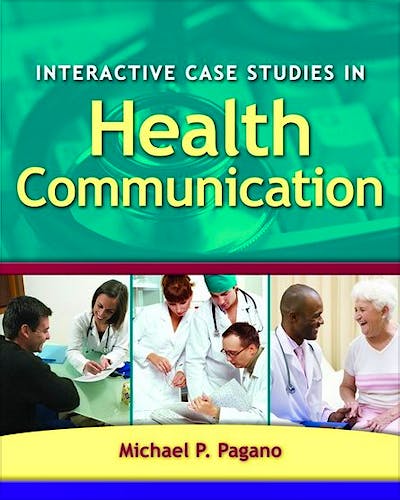

No hay productos en el carrito



Interactive Case Studies in Health Communication
Pagano, Michael
1ª Edición Marzo 2009
Inglés
Tapa blanda
281 pags
1000 gr
null x null x null cm
ISBN 9780763760182
Editorial JONES AND BARTLETT
LIBRO IMPRESO
-5%
36,54 €34,71 €IVA incluido
35,13 €33,38 €IVA no incluido
Recíbelo en un plazo de
2 - 3 semanas
"Real-life" case studies provide your students with a unique learning opportunity!
Interactive Case Studies in Health Communication allows students and faculty to explore real-life health communication behaviors through role-playing, interactive exercises, and examples that have been adapted from actual healthcare situations. The interactive format asks readers to assess the health communication and information exchange that occurs in the initial scenario of each chapter, then to answer questions about their observations and assessments. The student then has the opportunity to rewrite the scenario in order to enhance the interpersonal communication, relationship-building, and decision-making between the participants. An alternate scenario is also presented to provide readers with an example to compare to their rewrite.
Interactive Case Studies in Health Communication covers a wide variety of health communication topics including nonverbal communication, family communication, telephone conversations, managed care, emotional issues, hostile patient or family members, the media’s impact on provider-patient communication, intercultural communication and end-of-life conversations. This book also highlights the importance of interpersonal communication and relationship-building for information sharing and collaborative decision-making.
The purpose of this text is to inform and enhance classroom discussions of health communication by providing real-life examples of various communication behaviors including:
• Provider-provider
• Provider-patient
• Patient-family
• Provider-3rd party
• Patient-3rd party
• Media-provider
• Media-patient/consumer
Each chapter includes role play scenarios, discussion questions and interactive activities, and key points!
Table of Contents
Preface
Dedication
Using This Text
Section 1 Provider Communication
Chapter 1 Learning to Talk Like a Health Care Provider
Chapter 2 See One, Do One, Teach One
Chapter 3 The Biomedical Model
Chapter 4 The Biopsychosocial Model
Chapter 5 Autonomy is a Myth
Chapter 6 Bad News
Chapter 7 Closings
Chapter 8 Follow-Up
Chapter 9 I’ve Got the License, so We’re Doing it My Way
Section 2 Patient Communication
Chapter 10 What’s Wrong with Me?
Chapter 11 I Understand
Chapter 12 It’s Been 2 Hours
Chapter 13 Why Do I Have to Wait for an MRI?
Chapter 14 I’m Feeling Better, But…
Chapter 15 We Don’t Know What to Do
Chapter 16 I Hurt My Back
Section 3 The Media and Health Communication
Chapter 17 Erectile Dysfunction
Chapter 18 I’ve Got a Defibrillator
Chapter 19 I Saw this Ad on Television
Chapter 20 Education or Promotion?
Chapter 21 How About Cereal for My Cholesterol?
Chapter 22 Are Vaccines Safe?
Section 4 Role of Third Parties in Health Communication
Chapter 23 How Safe are Generics
Chapter 24 I Can’t Work
Chapter 25 You’ll Feel Better Recovering At Home
Chapter 26 I Only Have 9 Minutes or So
Chapter 27 Why Don’t You Tell Me About It?
Section 5 Culture and Health Communication
Chapter 28 We Just Need to Get Through the Chemo
Chapter 29 No Hablo Espanol
Chapter 30 HIPAA
Chapter 31 When Can My Employee Return to Work?
Chapter 32 Please Take Off Your Clothes and Put On This Gown
Chapter 33 Don’t Tell My Wife She’s Dying
About the Author(s)
Michael P. Pagano, PA-C, PhD - Department of Communication, Fairfield University
The author is a practicing PA with nearly 3 decades of experience and expertise. He was at one time a Professor and Chair of a PA program in Chicago. He currently works in a Level II Trauma Center/Emergency Department and in an Occupational Health Services Department of a suburban hospital. Over the years, he has worked in numerous medical areas, including surgery, family practice, emergency departments, corporate health, women’s health/family planning and occupational medicine. He intends to use his experience and education to assure that the case studies are accurate representations of communication behaviors and provide a wide array of settings and situations for professors and readers to explore, assess and critique. The author also has his PhD in Communication and will use his health communication background to help illustrate the shortcomings of some of the examples and emphasize interactive ways to help aid assimilation, critical thinking and analyses. Over the years, he has written numerous journal articles, published several textbooks and presented at a host of different conferences.
© 2026 Axón Librería S.L.
2.149.0